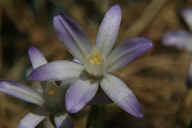Taxon Report
Brodiaea pallida Hoov.Chinese Camp brodiaea |
 © 2014 Robert E. Preston, Ph.D. |
Taxon Summary
Brodiaea pallida, commonly known as Chinese Camp brodiaea, is a perennial bulbiferous herb in the Themidaceae that is found only in California. It occurs within Cismontane woodland, and Valley and foothill grassland, growing at elevations from 165 to 385 meters. Brodiaea pallida is ranked 1B.1, Plants Rare, Threatened or Endangered in California and Elsewhere; Seriously threatened in California.Classification
|
Scientific Name: |
Brodiaea pallida Hoov. |
|
Common Name: |
Chinese Camp brodiaea |
| Family: | Themidaceae |
| Element Code: | PMLIL0C0C0 |
| USDA Plants Symbol: | BRPA2 |
|
Synonyms/Other Names: |
|
Ecology and Life History
| Lifeform: | perennial bulbiferous herb |
| Blooming Period: May-Jun | May-Jun |
| Elevation: | 165-385 (540-1265) |
| General Habitats: | Cismontane woodland, Valley and foothill grassland |
| Microhabitat: | Serpentine (often) |
| Microhabitat Details: | vernal streambeds |
Conservation Status
| CA Rare Plant Rank: | 1B.1 |
| Global Rank: | G1 |
|
State Rank: |
S1 |
| State List: | CE |
| Fed List: | FT |
| Other Status: | IUCN_EN |
|
CRPR Changes: |
|
Occurrence Data from the CNDDB
| Total Occurrences: | 5 |
| Element Occurrence Ranks: | |
| Excellent (A) | 1 |
| Good (B) | 2 |
| Fair (C) | 2 |
| Poor (D) | 0 |
| None (X) | 0 |
| Unknown (U) | 0 |
| California Endemic: True | |
| California Counties and Islands: Name (Code) | |
| Calaveras (CAL), Tuolumne (TUO) | |
| Quads: Name (Quad Code) | |
| Chinese Camp (3712074), Copperopolis (3712086), New Melones Dam (3712085) | |
Threat List Data from the CNDDB
| Threat List Total: | 7 | |
| EOs with Threat Listed: | Total EOs | % of EOs |
| 2 | 40 % | |
| Development | 2 | 40% |
| Road/trail construction/maint. | 2 | 40% |
| Erosion/runoff | 1 | 20% |
| Grazing | 1 | 20% |
| Altered flood/tidal/hydrologic regime | 1 | 20% |
| Biocides | 1 | 20% |
| Dam/Inundation | 1 | 20% |
Citation
California Native Plant Society, Rare Plant Program. 2025. Rare Plant Inventory (online edition, v9.5.1). Website https://www.rareplants.cnps.org [accessed 24 December 2025].